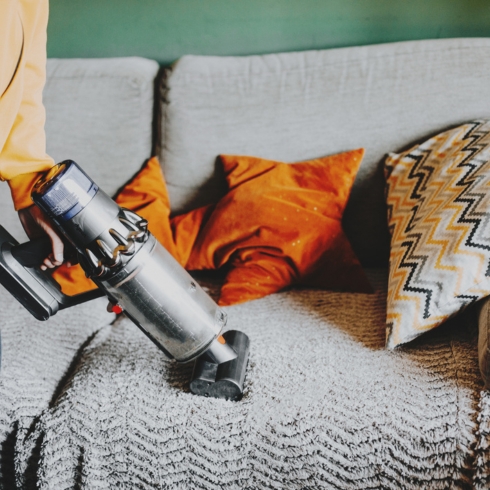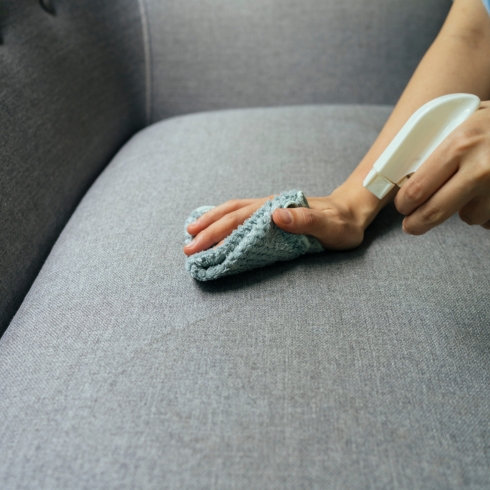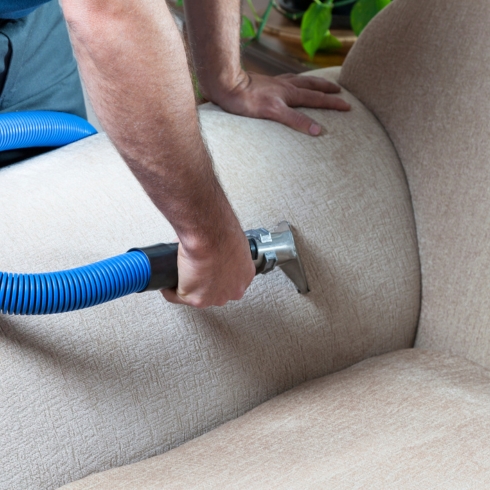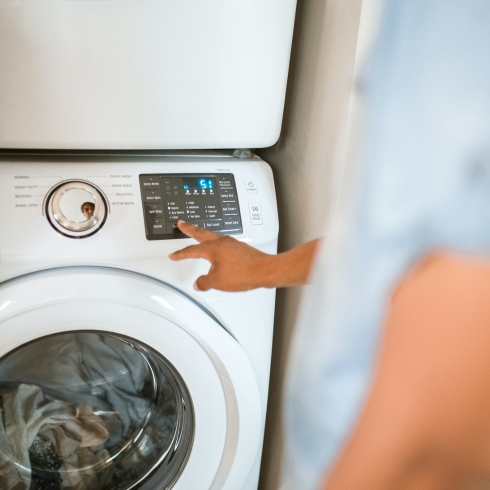It’s the place you chat with family. Binge-watch the latest shows, entertain friends, snack, scroll, you name it—your couch is one of the most high-traffic pieces of furniture in your home. But how often are you cleaning your sofa or sectional? With the 500 million skin cells we inevitably shed daily, it’s likely not enough. In this comprehensive how-to guide, we’ll share exactly how to clean your fabric, leather or microfiber couch without damaging its upholstery.

Read and Research
Before you get started cleaning your couch—stop! That was a bit aggressive, but it’s important that before you add any fancy looking upholstery cleaners in your Amazon cart or throw a load of cushion covers in the wash, you read the cleaning instructions provided by your couch’s manufacturer.
Knowing the material and recommendations for your specific sofa is the most important takeaway of this entire guide. Just like your favourite sweater, your sofa comes with handy cleaning instructions that should be followed to maintain its condition and avoid damaging the material.
Here’s how to decode your couch’s washing tag:
- W: Wet or water-based cleansers can be used
- S: Solvent clean with dry cleaner detergent
- WS: Wet or solvent cleaning methods can be safely used
- X: No water can be used; vacuum only
If you are unable to find a cleaning tag on your couch, contact the manufacturer for more information.

Vacuum Debris
Couches are an investment and to keep them in good condition for years to come, regular care is essential and for the most part that means vacuuming. Once a week (or more frequently depending on if you have pets, kids, etc.), vacuum your sofa from top to bottom using the upholstery tool, ensuring you get into all crevices where pet hair, dust, dirt and food crumbs accumulate. Each time you vacuum, take the time to fluff and rotate your cushion so that the fillings are distributed and wear evenly.
Pro Tip: Once a month take your removable sofa cushions outside and beat them with an old tennis racket or broom handle.
You’d be surprised (and slightly disgusted) how much debris comes out even after vacuuming!

How to Remove Couch Stains
Regardless of what material your couch upholstery is, patch testing when trying a new cleaning technique or product is a must. Find an ambiguous spot on your couch to determine whether your new cleaning method will discolour or react poorly with your sofa’s fabric. Do not move on to cleaning the rest of your couch until you are absolutely certain the product is safe to use.
Unfortunately, there’s not a universal solution for all couch materials so let’s break down the best solutions for the three most common upholstery choices: fabric, leather and microfiber.

How to Clean a Fabric Couch
Fabric couches can range from cotton, linen or anything in between, so always patch test to make sure the following solution is suitable for your couch’s specific material. Mix together one part vinegar, three parts warm water and a tablespoon of dish soap into a spray bottle. Lightly mist the stained area before using a soft cloth move with the direction of the fabric. Use a secondary moistened cloth with just water to lift the stain and remove the soap. Bloat dry with a towel and allow to air dry fully.
Pro Tip: If the weather allows, open the windows to help air dry your couch. Water should be used sparingly on fabric couches as excess water logged in the fabric or cushions can cause mildew.

How to Clean a Leather Couch
Leather couches are durable and wear beautifully if taken care of properly. For stains on leather upholstery, mix two parts white vinegar with one part water in a bowl. Dampen a microfibre cloth and use circular motions to lift up the dirt, refreshing the cloth often. For dark stains, create a paste of one part lemon juice and one part cream that can be rubbed onto the stain and left for 10 minutes. Simply remove it with a damp cloth and repeat if necessary—you’ll notice the bowl will get cloudy with dirt, so do not be afraid to dump it and start again.
Since leather dries out, applying a conditioner (our top choice is Leather Honey, which has 50,000 raving reviews on Amazon) will help moisturize and prevent cracking.

How to Clean a Microfiber Couch
You choose wisely— microfiber, made from synthetic materials like polyester and nylon, is known for being resilient and easy to clean. But microfiber couches are also susceptible to showing watermarks so when cleaning, it’s best to avoid any soaking of the material. Instead, pour rubbing alcohol into a spray bottle and spitz a light layer over stains, armrests and the other most high-use areas.
Wipe with a microfiber cloth and repeat until dirt and stains lift. To finish, use a dry bristle brush to fluff the fabric in circular motions.
Pro Tip: Only use white microfiber cloths and sponges when cleaning upholstery as the dye from other colours may transfer and stain your upholstery.

How to Steam Clean Your Couch
Dust mites, the tiny microscopic relatives of the spider, and other allergens love to hangout on your couch as much as you do (trust us, don’t Google images of them). Luckily, steam cleaning can effectively kill bacteria and germs living in your couch without the use of chemicals due to its high temperatures.
After pretreating any stains, use an upholstery handheld steamer to work in a pattern over your couch’s most high-traffic areas. This will help prevent you from targeting any particular area more than once, which can lead to waterlogging (mildew’s happy place). Allow your couch to air dry by opening windows and using fans.
Pro Tip: Dust mites love hanging out in your bed too. Once you’re done with the couch, check out this complete guide to cleaning your mattress.

Machine Washing Your Couch
If your sofa upholstery can be machine washed (double-check the manufacturer’s recommendations to confirm), it’s best to wash cushion covers on a cold, delicate cycle.
Avoid detergents and pods with dyes (clear is always safer), and ensure all covers are completely zipped before being placed in the machine basin. Even if you only have a spill on one, it’s best to wash all cushion covers at once to avoid any uneven fading and to hang them to dry to avoid any shrinking.

How to Clean the Rest of Your Couch
With all this focus on your couch’s upholstery, don’t forget about the hard surfaces. Your couch’s legs and base can collect dust just as the high-traffic cushions do, especially being so close to the floor. Most couches have a cambric dust cover lining the underneath area of the couch which prevents debris from getting inside the frame. While this is great for keeping the dust out of your couch, it also tends to attract dust.
Along with using an all-purpose cleaner and microfiber cloth to dust any hard surfaces of your couch, you should be vacuuming the cambric dust cover and floor beneath your couch monthly—if not, weekly!

How to Deodorize Your Couch
Is your couch smelling a little…off? There’s a simple universal fix to eliminate odours and leave your couch smelling as good, actually better, than new. Sprinkle a light coat of baking soda over all upholstered surfaces of your sofa; using a baking sifter can help you do so evenly.
Allow the baking soda’s natural absorbent capabilities to bind and neutralize odours for a minimum of 20 minutes before vacuuming up the residue. For more severe smells, allow the baking soda to sit overnight. Regularly washing throw pillows and blankets. Additionally, using specific antibacterial fabric sprays can also help keep your couch smelling fresh.
Pro Tip: Applying a fabric water guard, like Scotchgard, to your upholstery every six months can help repel spills and prevent stains. Learn how to Scotchgard your couch here.
Home Network your inbox.
By clicking "SIGN UP” you agree to receive emails from Home Network and accept Corus' Terms of Use and Corus' Privacy Policy.




